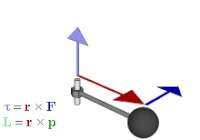
Photo from wikipedia
We present a lattice determination of the leading-order hadronic vacuum polarization (HVP) contribution to the muon anomalous magnetic moment, $a_{\mu}^{\rm HVP}$, in the so-called short and intermediate time-distance windows, $a_{\mu}^{\rm… Click to show full abstract
We present a lattice determination of the leading-order hadronic vacuum polarization (HVP) contribution to the muon anomalous magnetic moment, $a_{\mu}^{\rm HVP}$, in the so-called short and intermediate time-distance windows, $a_{\mu}^{\rm SD}$ and $a_{\mu}^{\rm W}$, defined by the RBC/UKQCD Collaboration [1]. We employ gauge ensembles produced by the Extended Twisted Mass Collaboration (ETMC) with $N_f = 2 + 1 + 1$ flavors of Wilson-clover twisted-mass quarks with masses of all the dynamical quark flavors tuned close to their physical values. The simulations are carried out at three values of the lattice spacing equal to $\simeq 0.057, 0.068$ and $0.080$ fm with spatial lattice sizes up to $L \simeq 7.6$~fm. For the short distance window we obtain $a_\mu^{\rm SD}({\rm ETMC}) = 69.27\,(34) \cdot 10^{-10}$, which is consistent with the recent dispersive value of $a_\mu^{\rm SD}(e^+ e^-) = 68.4\,(5) \cdot 10^{-10}$ [2]. In the case of the intermediate window we get the value $a_\mu^{\rm W}({\rm ETMC}) = 236.3\,(1.3) \cdot 10^{-10}$, which is consistent with the result $a_\mu^{\rm W}({\rm BMW}) = 236.7\,(1.4) \cdot 10^{-10}$ [3] by the BMW collaboration as well as with the recent determination by the CLS/Mainz group of $a_\mu^{\rm W}({\rm CLS}) = 237.30\,(1.46) \cdot 10^{-10}$ [4]. However, it is larger than the dispersive result of $a_\mu^{\rm W}(e^+ e^-) = 229.4\,(1.4) \cdot 10^{-10}$ [2] by approximately $3.6$ standard deviations. The tension increases to approximately $4.5$ standard deviations if we average our ETMC result with those by BMW and CLS/Mainz. Our accurate lattice results in the short and intermediate windows point to a possible deviation of the $e^+ e^-$ cross section data with respect to Standard Model predictions in the low and intermediate energy regions, but not in the high energy region.
Journal Title: Physical Review D
Year Published: 2022
Link to full text (if available)
Share on Social Media: Sign Up to like & get
recommendations!